Top 7 Active Listening Activities to Boost Team Communication
We all think we're good listeners, but how often are we just waiting for our turn to speak? This common habit leads to misunderstandings, missed opportunities, and weakened team dynamics. True active listening, the skill of fully concentrating on what is being said rather than just passively 'hearing' the message, is the foundation of effective communication. It's not a passive act; it’s a powerful tool that requires conscious effort and practice.
Strong listening skills are essential for building trust, fostering genuine connection, and creating a positive workplace culture. In this guide, we'll move beyond theory and dive straight into practical, hands-on active listening activities. These exercises are designed to transform how you and your team communicate, helping you understand intent, not just words.
You won't find vague advice here. Instead, you'll get seven actionable exercises you can implement immediately, from "Paraphrasing Practice" to the "Back-to-Back Drawing" challenge. Prepare to engage in fun, insightful activities that will sharpen one of the most critical skills in any professional setting, whether you're on the warehouse floor or in the boardroom. Let's get started.
1. Paraphrasing Practice
Paraphrasing is more than just repeating someone's words; it's about digesting what you've heard and restating it in your own words to confirm your understanding. This foundational technique, championed by figures like Carl Rogers and Stephen Covey, is one of the most powerful active listening activities because it immediately shows the speaker you're engaged and genuinely trying to grasp their perspective. It builds trust and significantly reduces misunderstandings.

This exercise forces you to move beyond simply hearing sounds to actively processing meaning. By rephrasing the content, emotion, and intent behind the message, you validate the speaker's feelings and ensure you're both on the same page before responding. It's a skill that transforms conversations from parallel monologues into true dialogues.
How to Implement This Activity
You can practice paraphrasing in pairs or small groups. Designate one person as the "Speaker" and the other as the "Listener."
- The Speaker: Shares a brief story, opinion, or a description of a recent work challenge for 1-2 minutes.
- The Listener: Listens intently without interrupting. When the speaker finishes, the listener paraphrases the message back.
- Confirmation: The listener should ask, "Did I get that right?" to give the speaker a chance to clarify any missed details.
- Switch Roles: After a successful paraphrase, the participants switch roles and repeat the exercise.
Tips for Effective Paraphrasing
- Use starter phrases: Begin with phrases like, "So, if I'm understanding you correctly…" or "It sounds like you're feeling…" to signal your intention.
- Capture emotion, not just facts: Don't just repeat the situation. Acknowledge the underlying feelings. Instead of "Your report is late," try "It sounds like you're feeling overwhelmed by the deadline for that report."
- Avoid adding your own opinion: The goal is to reflect their message, not to judge it or offer solutions immediately. Stick to what they said.
This practice is crucial for anyone in a role that involves conflict resolution, customer service, or management. It directly supports a healthier feedback loop, which is essential for fostering a culture of continuous growth. Consistently using this skill helps build psychological safety and makes team members feel truly heard.
2. Reflective Listening Circles
Reflective Listening Circles create a structured, safe environment for deep communication by drawing on traditions like indigenous talking circles and approaches from figures like Parker Palmer. In this group activity, participants take turns speaking without interruption while the others focus solely on understanding their message. It’s one of the most powerful active listening activities for building team cohesion and psychological safety.
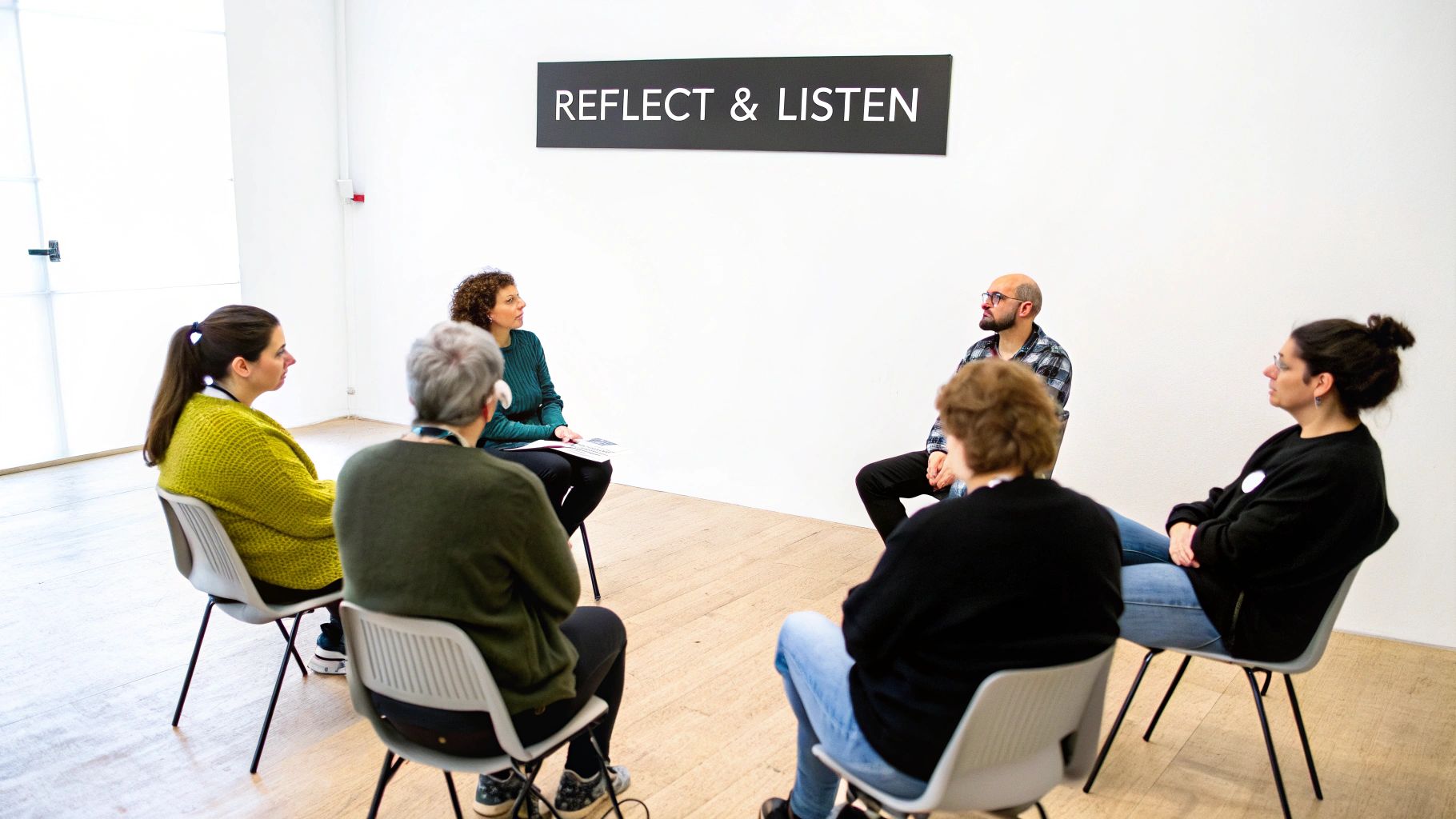
This method shifts the dynamic from debate to shared understanding. By removing the pressure to respond or problem-solve immediately, listeners can fully absorb the speaker's perspective, including the emotions and values behind their words. It fosters empathy and connection, making it an invaluable tool for teams looking to build trust and navigate complex conversations.
How to Implement This Activity
This activity is best facilitated in a small group seated in a circle to promote a sense of equality and connection.
- Set the Stage: A facilitator establishes clear ground rules, such as confidentiality, no interruptions, and speaking from personal experience.
- The Speaker: One person starts, holding a "talking piece" (like a pen or stone) to signify it's their turn. They speak for a set time (e.g., 2-3 minutes) on a chosen topic.
- Reflective Listening: When the speaker finishes, the person next to them (or a designated listener) reflects back what they heard, focusing on the core message and emotions. They might say, "What I heard you say was…"
- Rotate: The talking piece is passed to the next person, and the process continues until everyone who wishes to speak has had a turn.
Tips for Effective Listening Circles
- Establish clear ground rules: Ensure everyone agrees to create a judgment-free zone. This includes no advice-giving unless explicitly requested.
- Start with lighter topics: Begin with low-stakes prompts like "a recent small win" before moving to more significant professional or personal challenges.
- Have a skilled facilitator: A facilitator is crucial for keeping time, gently enforcing rules, and guiding the group if the conversation stalls or becomes tense.
- Focus on 'I' statements: Encourage speakers to share from their own perspective ("I feel…") rather than making generalizations ("People think…").
This practice is exceptionally effective for team-building workshops, community dialogues, and educational settings. It can be a foundational element in developing stronger team dynamics and is a key component of many successful workplace conflict resolution strategies. By creating a space for every voice to be heard and valued, listening circles build a resilient and empathetic team culture.
3. Back-to-Back Drawing
Back-to-Back Drawing is a classic and engaging exercise that brilliantly illustrates the challenges of one-way communication and the need for precision in both speaking and listening. In this activity, one person describes an image while their partner, sitting back-to-back, attempts to draw it based solely on those verbal instructions. It's one of the most effective active listening activities for revealing how easily messages can be misinterpreted without clarification and visual feedback.
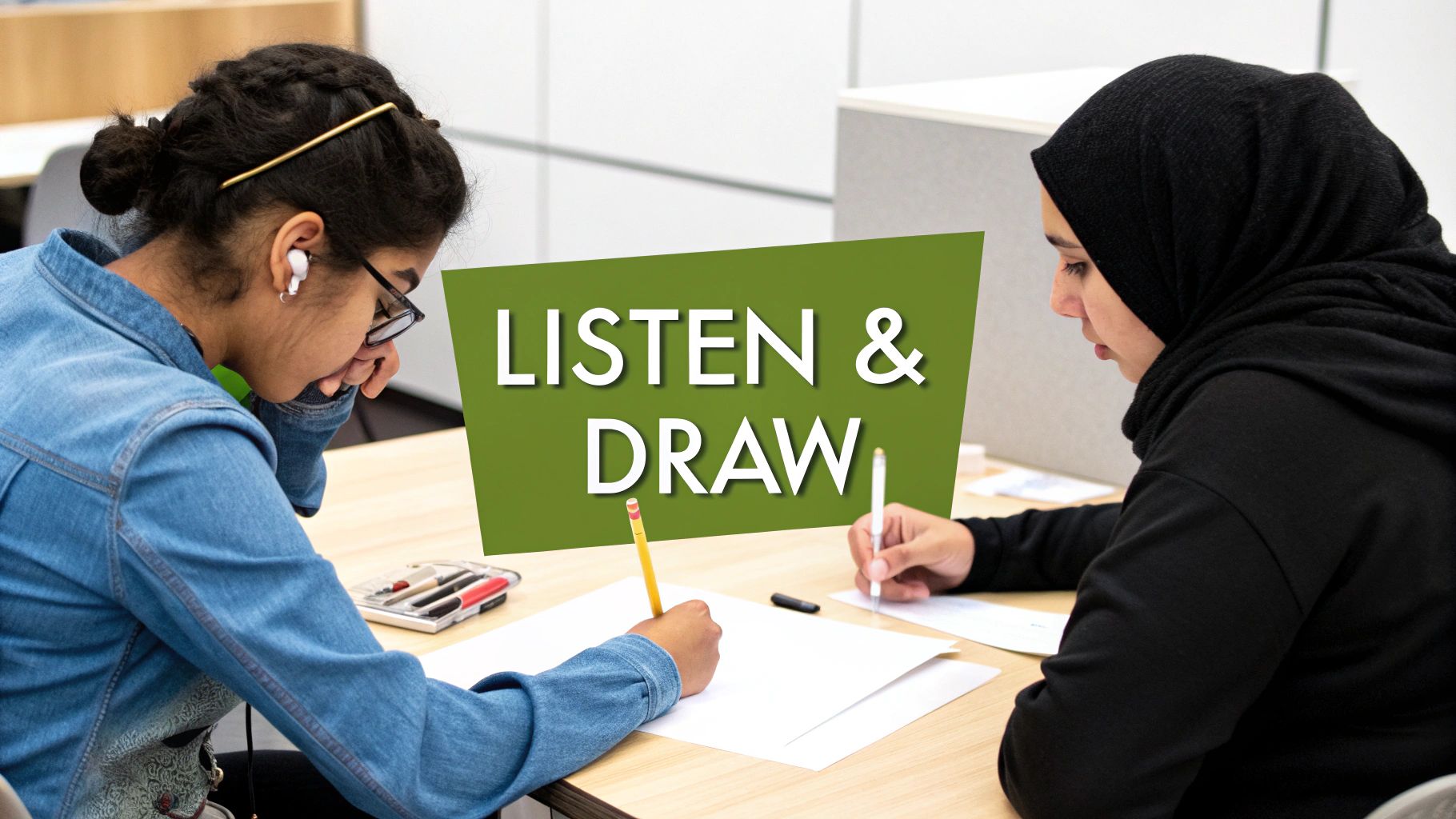
This exercise forces the listener to hang on every word, visualizing instructions and translating them into a physical form. It highlights gaps in communication, the ambiguity of common words, and the assumptions we make when we listen. The often humorous and mismatched final drawings serve as a powerful, tangible metaphor for what happens when communication breaks down in the workplace.
How to Implement This Activity
This activity is perfect for pairs and can be scaled for any group size. All you need is paper, pens, and a few simple images.
- Form Pairs: Have participants pair up and sit on the floor or in chairs back-to-back.
- Assign Roles: Designate one person as the "Describer" and the other as the "Drawer." Give the Describer a simple image (e.g., a house with a sun, a sailboat, a combination of geometric shapes).
- Give Instructions: The Describer provides verbal instructions on how to draw the image without naming what it is. The Drawer can only listen and draw; they cannot ask questions or speak.
- Reveal and Discuss: After a set time (2-3 minutes), have the pairs compare the original image with the drawing. Debrief on what was difficult and where communication failed.
- Switch Roles: Have the partners switch roles with a new image to experience both sides of the communication dynamic.
Tips for an Effective Drawing Session
- Start Simple: Use basic geometric shapes or very simple line drawings for the first round to build confidence.
- Be Specific with Language: Describers should focus on using precise directional and descriptive words like "Draw a 2-inch vertical line in the upper left corner" instead of "Draw a line over there."
- Debrief Thoroughly: The real learning happens in the post-activity discussion. Ask questions like, "What assumptions did you make as the listener?" and "What words caused the most confusion?"
- Try a Variation: For a second round, allow the Drawer to ask only "yes" or "no" questions. This shows how even limited feedback dramatically improves understanding.
This exercise is a fantastic icebreaker or training module for teams that rely on clear communication, such as project management, design, and remote teams. It provides an immediate and memorable lesson on the importance of clarity and the pitfalls of assumption.
4. Story Building Chain
The Story Building Chain is a collaborative and creative exercise that sharpens listening skills in a dynamic group setting. Participants build a story together, one sentence at a time, with each contribution needing to logically follow the previous one. Popularized by improvisational theater and creative writing instructors, this is one of the most engaging active listening activities because it requires participants to listen, comprehend, and then build upon what they’ve just heard.

This activity is effective because there's no way to "cheat" or plan ahead. You cannot formulate your sentence until the person before you has spoken, forcing you to be completely present and attentive to the narrative's details, tone, and direction. It highlights how easily we can miss key information if we are only focused on what we want to say next, transforming listening from a passive act into an active, creative one.
How to Implement This Activity
This exercise works best in a group of five or more people, sitting in a circle to ensure everyone can hear and see each other clearly.
- Set the Scene: A facilitator provides a simple opening line to start the story (e.g., "The old clock in the town square suddenly struck 13.").
- Add a Sentence: The first person in the circle adds one sentence that logically continues the story.
- Pass it On: The turn passes to the next person, who must add their own sentence that connects directly to what the previous speaker said.
- Continue the Chain: The story continues to build around the circle until it reaches a natural conclusion or the facilitator calls time.
Tips for an Effective Story Chain
- Establish boundaries: Before starting, agree on a genre or theme (e.g., mystery, comedy, sci-fi) to give the story some direction.
- Focus on emotions: Encourage participants to build on the emotional cues from the previous sentence, not just the plot points.
- Keep it brief: Set a soft time limit (e.g., 10-15 seconds per person) to keep the energy up and prevent overthinking.
- Debrief afterward: Discuss the experience. Ask participants where they struggled to listen and what made it easier to connect their ideas to others.
This is an excellent exercise for corporate team-building events and therapeutic group activities. It not only enhances listening but also fosters creativity and collaboration, providing a fun and memorable way to discover new strategies for boosting team morale. The activity promotes a shared experience and reinforces the importance of every individual's contribution to the collective goal.
5. Emotion Identification Practice
True communication goes beyond the literal meaning of words; it delves into the emotional landscape of the speaker. Emotion Identification Practice is a targeted listening activity focused on recognizing and reflecting the feelings behind a message. Pioneered by thought leaders like Daniel Goleman and Brené Brown, this technique teaches you to listen for tone, pace, word choice, and nonverbal cues to understand not just what someone is saying, but how they feel about it.
This exercise is one of the most powerful active listening activities because it builds deep empathy and psychological safety. When you accurately acknowledge someone's feelings, you validate their experience, even if you don't agree with their point of view. This skill is critical for de-escalating conflict, offering meaningful support, and building authentic connections with colleagues.
How to Implement This Activity
This activity works well in pairs, using real or hypothetical workplace scenarios.
- The Speaker: Describes a situation that evoked a specific emotion, such as frustration with a project delay or excitement about a new opportunity. The speaker should focus on the experience for 1-2 minutes.
- The Listener: Listens without interruption, paying close attention to emotional cues.
- Reflect the Emotion: The listener identifies and names the emotion they heard. For example, "It sounds like you felt really disappointed when the client changed the requirements at the last minute."
- Confirm and Discuss: The listener asks, "Is that right?" allowing the speaker to confirm or correct the interpretation. They then switch roles.
Tips for Effective Emotion Identification
- Expand your emotional vocabulary: Move beyond simple terms like "sad" or "happy." Use more nuanced words like "apprehensive," "discouraged," "elated," or "overlooked."
- Notice incongruence: Pay attention when someone's words don't match their tone or body language. A statement like "I'm fine" delivered with a flat tone may signal something else is going on.
- Validate first, solve later: The goal is to acknowledge the feeling, not to fix the problem. Simply showing you understand the emotion is often the most helpful first step.
Mastering this skill is fundamental to creating a supportive and high-performing team environment. When team members feel their emotions are understood and respected, it dramatically enhances collaboration. This emotional attunement is a cornerstone for creating an environment where team members feel safe and connected, which is a key element when you want to learn how to build trust in teams.
6. Question Formulation Technique (QFT)
Asking the right questions is a direct result of deep listening. The Question Formulation Technique (QFT), developed by the Right Question Institute, is a structured process that transforms listening into an engine for inquiry. This method teaches you to generate, refine, and strategize questions based on what you’ve just heard, making it one of the most powerful active listening activities for developing critical thinking and engagement.
QFT shifts the focus from having immediate answers to formulating better questions. This process forces you to listen intently to identify gaps, assumptions, and core issues within a speaker’s message. By learning to produce your own questions, you move from a passive recipient of information to an active participant in the conversation, fostering deeper understanding and collaborative problem-solving.
How to Implement This Activity
This activity works well in groups, where participants can build on each other's curiosity. It’s based on a central "Question Focus" (QFocus), which can be a statement, image, or short video clip.
- Present a QFocus: Introduce a topic for discussion, such as "Our current feedback process is effective" or a short video of a customer testimonial.
- Generate Questions: Following the four rules of QFT, have participants brainstorm as many questions as they can about the QFocus in a set amount of time (e.g., 5-7 minutes). The rules are: ask as many questions as you can, do not stop to discuss or answer any question, write down every question exactly as it is stated, and change any statements into questions.
- Refine Questions: Participants then categorize their questions as either closed-ended (answerable with 'yes'/'no' or one word) or open-ended. They practice changing questions from one type to another.
- Prioritize and Discuss: The group chooses the most important questions and discusses their next steps for using them.
Tips for Effective QFT
- Focus on listening first: The goal isn't just to ask questions, but to ask questions that arise directly from what was presented. Listen completely before formulating.
- Embrace all questions: During the brainstorming phase, don't judge any question. The goal is quantity over quality initially to get the creative and analytical juices flowing.
- Balance open and closed questions: Understand the strategic value of both. Closed questions are great for confirming facts, while open questions encourage deeper exploration.
This technique is invaluable in any setting that requires problem-solving, innovation, or thorough analysis, from project kickoffs to post-mortems. By linking questions directly to careful listening, QFT builds a more thoughtful and inquisitive team culture, ensuring that discussions are driven by genuine curiosity rather than assumptions.
7. Mindful Listening Meditation
Mindful listening is a contemplative practice that elevates active listening from a mere technique to a state of full presence. Drawing on principles popularized by figures like Jon Kabat-Zinn and Thich Nhat Hanh, this activity trains you to listen with complete awareness, free from judgment or the internal pressure to formulate a response. It focuses on developing the foundational attention needed to truly hear what is being said, both verbally and non-verbally.
This exercise is one of the most transformative active listening activities because it tackles the root cause of poor listening: internal distraction. By practicing mindfulness, you learn to notice when your mind wanders to your to-do list, your next thought, or your own biases, and gently guide your focus back to the speaker. This builds the mental discipline required to stay present in any conversation, making others feel deeply respected and understood.
How to Implement This Activity
This practice can be done individually or in a group setting to foster a collective sense of presence.
- Find a Quiet Space: Begin in a comfortable, quiet environment where you can minimize external distractions.
- Start with Sounds: Close your eyes and focus on your breath for a minute. Then, expand your awareness to the ambient sounds around you. Simply notice each sound (a clock ticking, distant traffic, your own breathing) without labeling it as "good" or "bad."
- Introduce a Speaker or Audio: After a few minutes, transition to listening to a designated speaker, a guided meditation track, or a piece of instrumental music. Your only goal is to receive the sounds or words without analysis.
- Acknowledge Wandering Thoughts: When you notice your mind has drifted, gently and non-judgmentally acknowledge it, and then guide your attention back to the act of listening.
Tips for Effective Mindful Listening
- Start Small: Begin with short sessions of 5-10 minutes and gradually increase the duration as your focus improves.
- Focus on the Breath: Use your breath as an anchor. When you feel distracted, returning your attention to your inhales and exhales can help re-center you.
- Practice Non-Judgment: The goal is not to have a perfectly empty mind but to observe your thoughts without getting carried away by them. Let them pass like clouds in the sky.
This practice is incredibly beneficial for high-stress roles, helping individuals remain calm and centered during difficult conversations. It directly supports mental wellness and resilience, which are crucial for a healthy workplace. Implementing mindfulness is a powerful way to foster mental health at work, leading to more empathetic and effective communication across the entire organization.
Active Listening Activities Comparison
| Item | Implementation Complexity | Resource Requirements | Expected Outcomes | Ideal Use Cases | Key Advantages |
|---|---|---|---|---|---|
| Paraphrasing Practice | Low | Minimal (pairs or groups) | Improved comprehension and retention | Counseling, customer service, medical, conflict resolution | Builds understanding, reduces misunderstandings |
| Reflective Listening Circles | Moderate | Facilitator, group setting | Enhanced empathy, trust, emotional safety | Support groups, team building, education, community dialogue | Creates safe space, builds emotional intelligence |
| Back-to-Back Drawing | Low to Moderate | Materials needed (paper, pens) | Clear communication, listening accuracy | Corporate training, classrooms, team building | Tangible feedback, fun and engaging |
| Story Building Chain | Moderate | Group seating | Combined creative and listening skills | Creative writing, youth programs, team building, therapy | Engaging, builds creativity and listening |
| Emotion Identification Practice | Moderate to High | Skilled facilitator | Increased emotional intelligence, empathy | Therapy, parenting workshops, healthcare, conflict mediation | Deep emotional awareness and validation |
| Question Formulation Technique (QFT) | Moderate to High | Training in methodology | Critical thinking, curiosity, strong questioning | Education, medical, journalism, research | Systematic approach, builds questioning and listening |
| Mindful Listening Meditation | Moderate | Quiet space, guided sessions | Improved attention, reduced anxiety | Wellness programs, leadership training, therapy, education | Builds sustained attention, reduces reactive listening |
From Activity to Action: Making Active Listening a Daily Habit
We've explored a powerful toolkit of active listening activities, from the focused precision of Paraphrasing Practice to the creative collaboration of the Story Building Chain. You've seen how exercises like Back-to-Back Drawing can reveal our communication gaps and how Mindful Listening Meditation can ground us in the present moment. Each activity is more than just a one-off team-building event; it's a practical, repeatable workout for your communication muscles.
The true value of these exercises emerges not during the activity itself, but in the moments that follow. It happens when a manager uses reflective listening to truly understand a team member's concerns, or when a colleague uses the Question Formulation Technique to move a stalled project forward with insightful, clarifying questions. The goal is to bridge the gap between structured practice and spontaneous, real-world application.
Your Next Steps: Integrating Listening into Your Workflow
Completing these exercises is an excellent start, but the real transformation happens when these skills become second nature. The objective isn't just to "do" an activity; it's to fundamentally change how you show up in every single conversation. This shift doesn't require a massive overhaul, just small, consistent efforts.
Here’s how you can start today:
- Choose One Skill to Champion: Don't try to master everything at once. Pick one technique that resonated with you, like paraphrasing, and commit to using it at least once in every meeting you have this week. Notice the impact it has on the speaker and the clarity of the conversation.
- Create a "Listening First" Meeting Culture: Propose starting your next team huddle with a one-minute mindful listening moment to help everyone arrive fully present. Or, dedicate the last five minutes of a meeting to a quick Reflective Listening Circle, allowing everyone to share a key takeaway without interruption.
- Find an Accountability Partner: Pair up with a colleague who also wants to improve their listening skills. Offer each other gentle reminders and constructive feedback. A simple, "That was a great example of paraphrasing" can be incredibly motivating.
The Lasting Impact of True Connection
Mastering the art of active listening is not just about avoiding misunderstandings or being more efficient. It is a profound investment in building a healthier, more connected, and psychologically safe workplace. When people feel truly heard, they feel valued. This sense of value is the bedrock of trust, innovation, and genuine collaboration.
You are now equipped with a variety of active listening activities designed to build this essential skill. The journey from awareness to habit requires patience and persistence. Keep practicing, stay curious about the people you work with, and watch as better listening transforms not just your conversations, but your entire professional world. You have the power to create a ripple effect of understanding that strengthens your team and your career.
Ready to take your team’s communication and productivity to the next level? JIMAC10 provides innovative solutions to streamline warehouse operations, where clear, active listening is critical for safety and efficiency. Discover how our tools can help create a more connected and productive environment at JIMAC10.
Share this content:





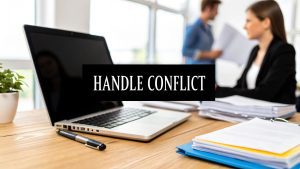









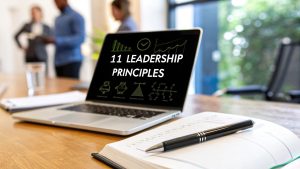

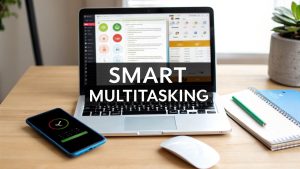
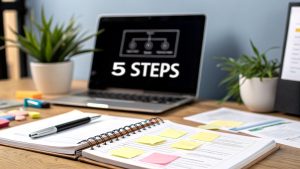
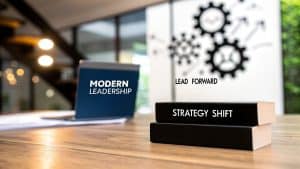



















1 comment